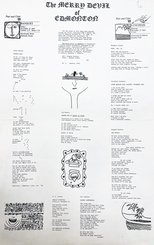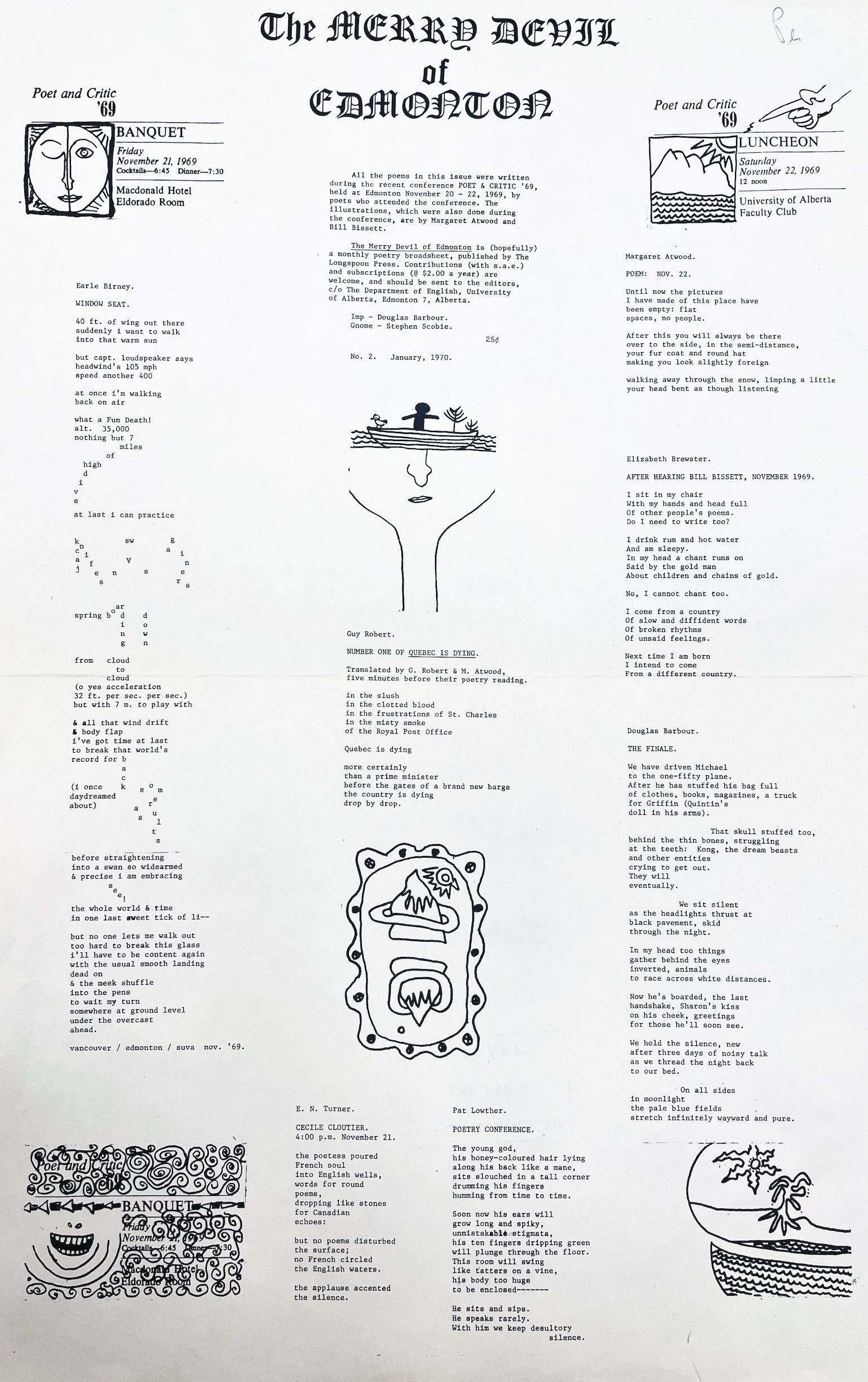
The Conference
The Poet & Critic Conference took place at the University of Alberta from November 20th to 22nd, 1969. It was jointly organized by the university’s Departments of English and Romance Languages. Its organizing committee was co-chaired by Bryan Dobbs, Richard Harrison, and Rudy Wiebe. The SpokenWeb UAlberta team has digitized and indexed 18 reel-to-reel audio tape recordings from this conference, allowing the public to listen to live performances and academic discussions from this poetic event almost 60 years ago. This initiative aims to shed light on the role played by the University of Alberta in the formation and development of poetry in Canada.
Leading up to the conference, the Edmonton Journal reported that it was “expected to be the largest event of its kind ever held in this country,” with over 200 participants, as well as “the first bilingual conference, the first to bring together academic critics and poetics, and the first to include the poetry of minority ethnic groups.”1
Presenters at the conference included many notable figures in Canadian poetry. Among these were Margaret Atwood, Gwendolyn MacEwen, Guy Robert, Dorothy Livesay, Jean-Guy Pilon Cécile Cloutier, Eli Mandel, and Earle Birney, and the then 26-year-old Inuit poet Mary Carpenter. Montreal Star reporter John Richmond described the lineup as “a whole chunk of the Oxford Book of Canadian Verse made flesh.”2 In all, around 40 poets and critics were invited as delegates to the conference, one-third of whom hailed from Quebec. Other attendees included students and faculty from across Canada.”3
The conference’s five sessions comprised paper presentations, round tables, and poetry readings in English and French. There were also various social events and a banquet for delegates.
The participants of Poet & Critic ’69 had a great deal to talk about. In the decade leading up to the conference, the Canadian writing scene had ballooned from a “locus of robust amateurism”4 to “a viable commercial proposition.”5 The proliferation of local small presses, literary magazines, funding sources, and an audience for Canadian writing had altered the landscape of Canadian literature permanently.6
The Recordings
It’s no wonder, then, that many Poet & Critic ’69 presentations paused to take stock of the present moment in Canadian writing. Gérard Tougas’s banquet presentation considered “The Expanding Universe of Canadian Literature’’ (SW182). Other presenters examined the works of Dorothy Livesay and Hector de Saint-Denys Garneau, two figureheads of an emerging Canadian (in the case of the latter, Québécois) poetic identity (SW112a, SW168-169, SW170-171). Not that this was a homogenous literary scene: Earle Birney’s presentation on “Poetry and Mixed Media” explored experimental forms, such as sound poetry, concrete poetry, and visual poetry (SW176). In these recordings, we get more than just poets discussing their poetic philosophies and research findings. We hear them passionately and creatively performing their own works, and through their dialogues, we experience a genuine sense of community-building among poets. These audio files powerfully fill in the gaps left by written records, capturing historical moments that words on paper might have missed. They offer us invaluable insights into how poets embody and interpret every single word and phrase in their craft.
In the recordings, we can hear poets from diverse generations engaging in lighthearted discussions about their differing viewpoints (e.g. SW165-166, a roundtable discussion featuring Margaret Atwood, bill bissett, and Eli Mandel sharing their perspectives on the “new scene” of contemporary poetry in Canada). Moreover, the audience actively participates in live poetry performances by posing questions, offering comments, and expressing their involvement through applause and laughter.
Coverage of the conference reflected this amiable atmosphere. Clive Cardinal, who presented on German and Polish-Canadian poetry, called the conference an “enormous success.”7 Richmond, the Montreal Star reporter, noted “the absence of ‘cliqueism,’” declaring, “As for the lowlights, leave them to the nit-pickers. This was a conference to boost not to knock.”8 Stanley Cooperman, a Vancouver Sun reporter, described the “entertaining fireworks” that emerged from both presenters and the audience, and cited a series of “[h]igh points” from the conference, including performances by George Jones, Irving Layton, and Guy Robert.9
The Prints
Poets’ responses to the conference were captured in a special edition of The Merry Devil of Edmonton, a poetry broadsheet. The broadsheet’s editors, Douglas Barbour and Stephen Scobie, were members of the Poet & Critic ’69 organizing committee. Their conference edition of Merry Devil includes works written during the conference by attending poets.
There is a palpable sense of altered reality in these poems, as if the collective literary re-imagining of the conference is slipping into the real world. For Earle Birney, the plane ride to Edmonton feels like “walking / back on air.”10 Of bill bissett’s poetry reading, Pat Lowther writes, “[t]his room will swing / like tatters on a vine.”11
Perhaps this augmented reality also results from the shock of gathering for a group of people used to an often-solitary career, for whom communication was rarely so instantaneous. The broadsheet itself is an indication of this closeness; Elizabeth Brewster and Pat Lowther’s poems about bill bissett’s reading are accompanied by illustrations created by bissett and Atwood. Guy Robert’s poem is noted as having been “[t]ranslated by G. Robert & M. Atwood, five minutes before their poetry reading.”12
In “The Finale,” the last poem of the broadsheet, Douglas Barbour reflects upon the conference’s lasting impact:
We hold the silence, new
after three days of noisy talk
as we thread the night back
to our bed.
On all sides,
in moonlight
the pale blue fields
stretch infinitely wayward and pure.13
Over fifty years later, the reverberations of Poet & Critic ’69 stretch on. The conference is a snapshot of the careers of poets and scholars of that moment, many of whom remain prolific to this day. It’s also an artifact of a distinctive moment not just in Canadian poetry, but in history and culture on a larger scale.
Notes
Fig. 1. Poet & Critic ’69 Conference Program Inner Page, Wilfred Watson fonds, University of Alberta Archives.
Fig. 2. “The Merry Devil of Edmonton”, Periodical, vol. 1, no. 2, January 1970, University of Alberta Archives.
-
Harvey, Bob. “A Poetic Pot-Pourri to Alert Academics and the Public.” Edmonton Journal, 14 Nov. 1969, p. 63. ↩︎
-
Richmond, John. “A Congress of Poets.” Montreal Star, 29 Nov. 1969, p. 2. ↩︎
-
Ibid. ↩︎
-
Atwood, Margaret. The Burgess Shale: The Canadian Writing Landscape of the 1960s. The University of Alberta Press, 2017, p. 35. ↩︎
-
Ibid., 42. ↩︎
-
Ibid., 39-42. ↩︎
-
Malycky, Alexander, and Clive Cardinal. “Postscripts.” Canadian Ethnic Studies, vol. 1, no. 2, Dec. 1969, p. 135. ↩︎
-
Richmond, John. “Individual Congress Reports.” Montreal Star, 29 Nov. 1969, p. 42. ↩︎
-
Cooperman, Stanley. “Embattled Poets Question Progress.” Vancouver Sun, 1 Dec. 1969, p. 29. ↩︎
-
Birney, Earle. “Window Seat.” The Merry Devil of Edmonton, vol. 1, no. 2, Jan. 1970. Edited by Douglas Barbour and Stephen Scobie. ↩︎
-
Lowther, Pat. “Poetry Conference.” The Merry Devil of Edmonton, vol. 1, no. 2, Jan. 1970. Edited by Douglas Barbour and Stephen Scobie. ↩︎
-
Robert, Guy. “Quebec is Dying.” Translated by Guy Robert and Margaret Atwood. The Merry Devil of Edmonton, vol. 1, no. 2, Jan. 1970. Edited by Douglas Barbour and Stephen Scobie. ↩︎
-
Barbour, Douglas. “The Finale.” The Merry Devil of Edmonton, vol. 1, no. 2, Jan. 1970. Edited by Douglas Barbour and Stephen Scobie. ↩︎


